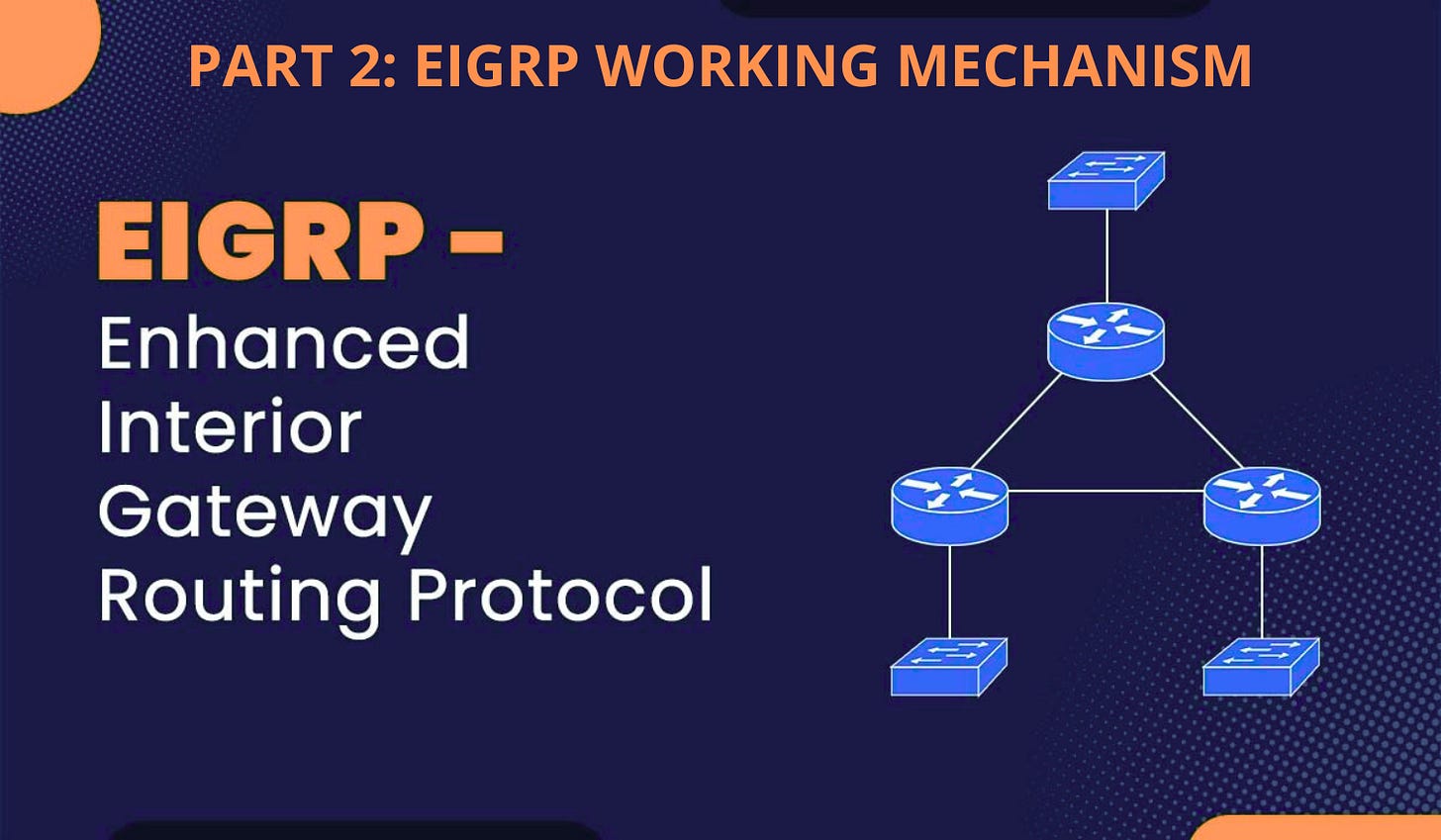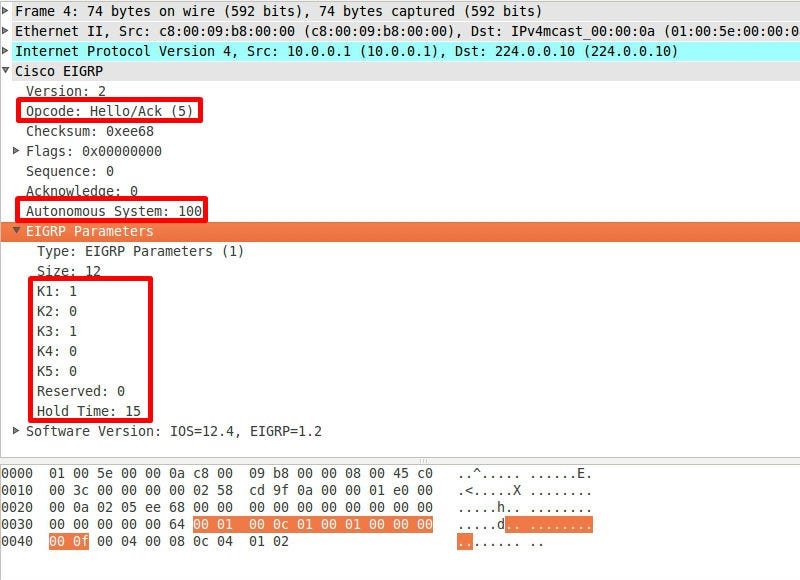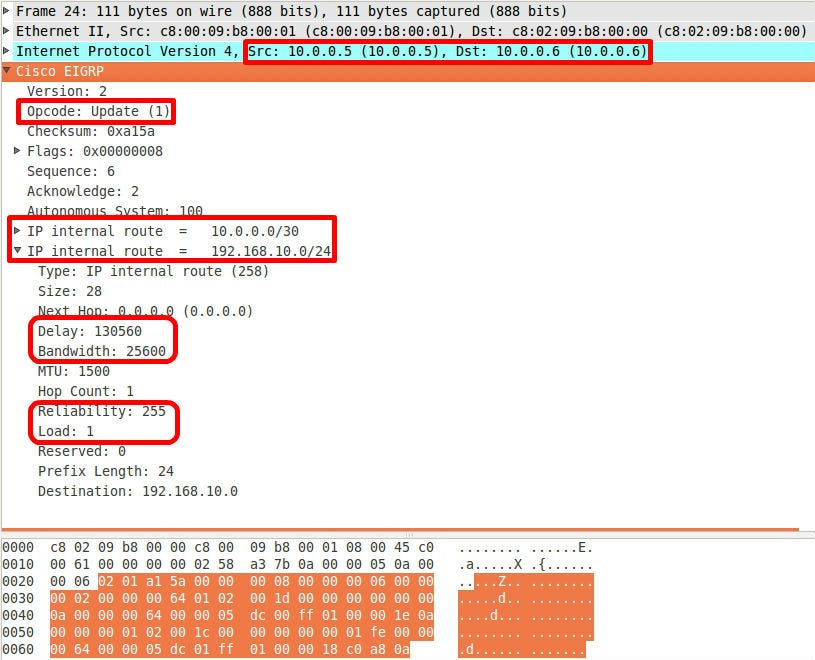PART 2: EIGRP Working Mechanism
Enhanced Interior Gateway Routing Protocol
Enhanced Interior Gateway Routing Protocol (EIGRP) operates through three phases when configured on a router. Let's explore each phase in detail, explaining how EIGRP establishes and maintains routing information.
Phase 1: Neighbor Discovery
When EIGRP is activated on a router interface (e.g., G0/0), the router initiates the neighbor discovery process:
Hello Packet Transmission: The router begins sending Hello packets from the interface's IP address to the multicast address 224.0.0.10.
Continuous Hello Exchange: If no EIGRP-enabled routers are present on the same Layer 2 segment, the router continues sending Hello packets at regular intervals defined by the Hello timer (typically 5 seconds for high-bandwidth links and 60 seconds for low-bandwidth links).
Parameter Verification: When another EIGRP router receives a Hello packet, it verifies several critical parameters:
IP subnet compatibility (both routers must be in the same subnet)
Matching Autonomous System (AS) numbers
Matching K-values (metric calculation parameters)
Authentication credentials (if enabled)
Common Issues During Neighbor Establishment
Several issues can prevent neighbor relationships from forming:
Subnet Mismatch: Generates "Neighbors not in common subnet" syslog message
Authentication Failure: Produces "Authentication Failure" syslog message
K-value Mismatch: Results in a "K-values Mismatch" syslog message
AS Number Mismatch: This is particularly dangerous as it produces no syslog message, requiring manual configuration verification
Neighbor Table Contents
Once all parameters are verified, each router adds the other to its Neighbor Table, which look like this:
Handle: sequence number indicating order of neighbor discovery (begins at 0)
Neighbor IP Address: IP address of the neighbor router interface
Local Interface: The local outbound interface connected to the neighbor
Hold Timer: Maximum time to wait for Hello packets before declaring the neighbor down
Uptime: Duration of the established neighbor relationship
SRTT (Smooth Round-Trip Time): Calculated from acknowledged message exchanges
RTO (Retransmission TimeOut): How long to queue an EIGRP packet before retransmission
Q Count: Number of EIGRP packets queued for transmission (normally 0)
Sequence Number: Last packet sequence number sent to this neighbor
Phase 2: Route Exchange, Topology Building, and Best Path Selection
After establishing a neighbor relationship, routers exchange routing information (Full update):
Route Exchange Process:
EIGRP routers share only the common EIGRP-enabled links.
EIGRP creates an Update packet (Type 1) containing:
Network prefix information
Vector metrics
Sequence number
Update Transmission Method:
On Ethernet (multi-access) networks: Updates are sent as multicast packets to 224.0.0.10
On point-to-point links (like serial interfaces): Updates are sent as unicast packets
Reliability Mechanism:
The receiving router acknowledges each Update with an ACK packet
If no ACK is received, the sender retransmits the Update as a unicast packet
Persistent failure to receive ACKs may indicate connectivity issues
Poison Reverse Implementation:
After acknowledging receipt, the receiving router sends a "poisoned" Update back to the source
This poisoned Update contains the same route but with an infinite metric (maximum delay value)
This process, a variant of Poison Reverse, helps prevent routing loops
The original sender must acknowledge this poisoned Update
Topology and Routing Table Population:
Received routes are placed in the Topology Table
The Diffusing Update Algorithm (DUAL) processes these routes
DUAL calculates metrics and determines loop-free paths
The best routes are installed in the routing table
Phase 3: Neighbor and Route Maintenance
Unlike other routing protocols, EIGRP uses a unique approach to maintain routing information:
Hello-Based Route Validation:
EIGRP relies on Hello packets as the primary mechanism to verify neighbor status
As long as Hello packets are received, routes learned from that neighbor are considered valid
This differs from RIP (which resends all routes periodically), OSPF (which refreshes LSAs each 30 Mints), and IS-IS (which refreshes LSPs)
Neighbor Failure Detection:
If Hello packets are not received within the Hold time, the neighbor is considered down
This triggers the Query and Reply process (covered in a separate note) to find alternative paths
EIGRP remains a distance vector protocol at its core. Unlike link-state protocols (OSPF or IS-IS) that maintain a complete network topology, EIGRP only knows about directly connected neighbors and the routes they advertise. This fundamental difference influences how EIGRP detects and responds to network changes.






